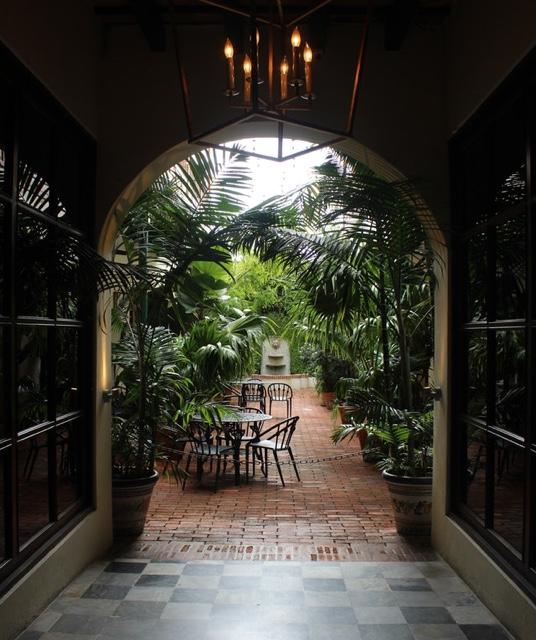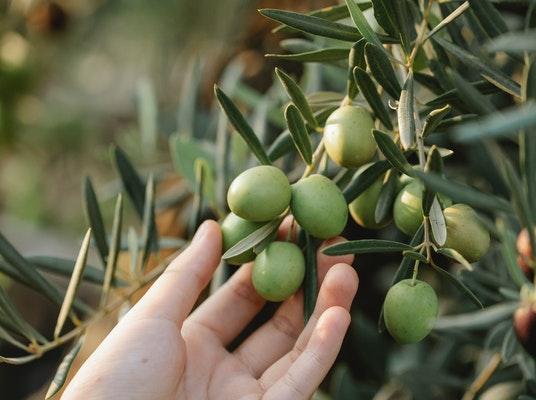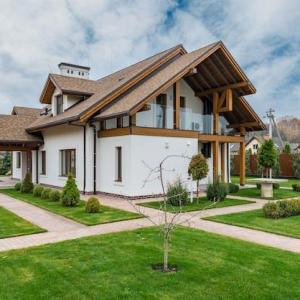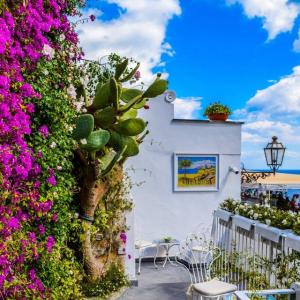

Since spectators may see the whole garden in a single look, small gardens are personal settings and need careful thinking when selecting hardscape elements and plants. However, the garden's size does not imply that it lacks diversity or appeal.
The best course of action is simplicity.
It is recommended to keep the garden design relatively simple in a small landscape with fascinating architectural components to prevent the landscape from seeming too cluttered. In this instance, basic potted geraniums are placed along a stone wall with beautiful texture—not a decision that often wins any garden prizes. These little patches of color and foliage really enhance the scenery.
The vivid bloomers with a tall growth habit that this gardener has selected catch the attention and provide a more substantial screen than smaller, less vibrant plants could. As they age, the little trees next to and behind the fence make the garden seem bigger.
The first thing you notice about the home is this little square garden, and despite how unassuming it may seem, it attracts attention and smiles from onlookers. Even though it is not a large garden, it has a dominating presence.
The greatest places for garden planting spaces in the front yards of modest houses are often regions along roads and roadways.

The selection of plants, including roses, clematis, and lavender nepeta, gives this garden area an immediately English air. The little garden border is set against the background of the little tree and overgrown lilac to the left, which helps to create a more cozy atmosphere. This pretty young garden seems older, more mature, and more abundant by employing rather big clusters of a select few plant kinds. The little garden is enhanced by bringing it inside since the garden bed is plainly seen via the big windows.
In this instance, the owners have planted low-maintenance blooming plants and bulbs all around their little patio. Even the roadside has a group of river birches that serve as a privacy screen. Despite the garden's recent planting, there are still enough plants for it to instantly be aesthetically pleasing. Additionally, the garden will mature gracefully thanks to the wise plant selection.

On any property with steeply sloping soil, retaining walls may be an efficient approach for flattening planting areas and reducing mowing slopes.
Utilizing a relatively limited number of bigger plants and arranging them in a pyramid shape with the biggest specimens in the middle is another strategy that may function rather well in tiny landscapes. The tendency is to jam as many plants as you can into a tiny garden, but this just makes the garden seem unnecessarily congested and pointless. Small gardens frequently benefit from less being more.
In order to ensure that there is always something in bloom, this gardener has built a garden wall with a variety of climbing clematis of varied sizes and bloom times. The fuzzy gray of the lamb's ear, along with the other plants that flow over the borders, softens the gray pavers, making it an excellent option for the patio's edge. But nothing around here needs a lot of upkeep. Although this area is small, it is lush.
In this illustration, the gardener has included raised beds with seats, a gravel walk that is simple to maintain, a sitting place for when you can't wait to enjoy the vegetables, and art nouveau-style deer fence. Sometimes something as mundane as fence may define an area more clearly than anything else. Fences may also provide a vertical dimension for climbing plants like pole beans or cucumbers.
It may be important to designate your garden as "all-vegetable" or "all-ornamental" since it might be challenging to make a small landscape satisfy all needs. A vegetable garden may, however, nevertheless be made to seem lovely by adding a few annual flowers here and there. It's important to keep in mind that many consumables have their own charm, such as the ripe lushness of tomatoes or the brilliant color of sunflowers. And as this vegetable garden's exquisite geometry demonstrates, smart design is also a kind of beauty.

Espalier is the practice of training and trimming trees to grow in two dimensions while growing fruit and other plants flat against a wall. The walled gardens of medieval Europe were where the art initially gained popularity. In addition to using less space, leaning trees up against a sunny wall produces a comfortable microclimate. Fruit trees that normally wouldn't bear in colder climates may be made to believe they are in a warmer climate. Additionally, an espalier's open structure allows more sunlight to enter, which promotes more flowers and quicker ripening. The beauty of the trees as they glisten in the sun next to your house is a last advantage.
The most typical fruit trees utilized with this method are apples and pears. Peaches, cherries, and plums are just a few examples of stone fruits that may be trained, however the pruning timetable will vary. In this illustration, the trees are situated in a border that is just about a foot broad.
The greatest places for garden planting spaces in the front yards of modest houses are often regions along roads and roadways.
Instead of using the special beauty of the available area, landscape designers all too often concentrate too much on attempting to make a tiny place seem larger. The gardeners show numerous methods for maximizing a tiny garden area by using scale to your advantage in the examples provided below.
It is recommended to keep the garden design relatively simple in a small landscape with fascinating architectural components to prevent the landscape from seeming too cluttered. In this instance, basic potted geraniums are placed along a stone wall with beautiful texture—not a decision that often wins any garden prizes. These little patches of color and foliage really enhance the scenery.
Breaking up the uniformity and introducing various shapes and textures are aged terra-cotta pots, evergreens, and succulents sprinkled throughout. An iron seat has been added to the once-simple gravel path that connected the home and garage to create a tranquil garden walk.
1. Adapt the Garden to a Goal
The more detailed you need to be about making sure your garden serves a certain function, the smaller it is. In order to build an effective and aesthetically pleasing screen to block sound and vision from the city street, a homeowner with a relatively tiny backyard but significant exposure along a busy street has combined garden plants with portions of conventional fence. Additionally, extra garden space is created by incorporating the planting bed within the fence treatment.2. Start Small and Individually
In this illustration, a little garden that is completely in proportion with the house itself is included into the driveway retaining wall to enliven a simple home. A personal touch is provided by a mass of rudbeckia, a few coneflowers, a morning glory vine clinging to the lamp post, and some comical figurines. The other yew-framed homes flanking the street might easily obscure this relatively little front yard. But every time they enter their driveway, these homeowners are greeted with a cheery splash of color. Long-blooming perennials are the secret to maintaining interest in a tiny garden like this one.The first thing you notice about the home is this little square garden, and despite how unassuming it may seem, it attracts attention and smiles from onlookers. Even though it is not a large garden, it has a dominating presence.
3. Think about the Welcome
In this instance as well, the gardener turned the area next to the driveway into a welcome-home garden. Coneflower, sedum, daylilies, and flowering shrubs are among the hardy, low-maintenance plants. But in this area, the area has grown and seems to be becoming even larger as it circles to the side of the road. In American front yards, free-flowing gardens are uncommon, yet in this instance, they don't look out of place.The greatest places for garden planting spaces in the front yards of modest houses are often regions along roads and roadways.

4. Combined Garden and House
If your land is modest, you could believe that you lack the room for a border of voluminous flowers. A sharp eye, though, is more valuable than a double-wide lot. A beautiful architectural feature of this home are the large windows on the gable side. Small gardens must use every resource at their disposal, in this example, the home's appealing architecture.The selection of plants, including roses, clematis, and lavender nepeta, gives this garden area an immediately English air. The little garden border is set against the background of the little tree and overgrown lilac to the left, which helps to create a more cozy atmosphere. This pretty young garden seems older, more mature, and more abundant by employing rather big clusters of a select few plant kinds. The little garden is enhanced by bringing it inside since the garden bed is plainly seen via the big windows.
5. Add Contemporary Comforts
For older baby boomers who no longer want to bend and move heavy objects required for landscape upkeep as well as for young professionals who just don't have the time, townhouse living has a lot to offer in terms of decreased lawn and garden maintenance. However, just because you live in a townhouse or apartment doesn't mean you have to submit to a backyard dominated by a patio made of concrete.In this instance, the owners have planted low-maintenance blooming plants and bulbs all around their little patio. Even the roadside has a group of river birches that serve as a privacy screen. Despite the garden's recent planting, there are still enough plants for it to instantly be aesthetically pleasing. Additionally, the garden will mature gracefully thanks to the wise plant selection.

6. Pick Your Hardscape Materials Wisely
You could have space to experiment with various materials for pathways, retaining walls, patios, and other landscape elements on a very big property. Such diverse designs often look well in relatively expansive environments. However, smaller dwellings need the use of landscape construction materials that complement or coordinate with those used in the actual residence. Natural landscape components, such the stone retaining wall and garden wall, are required for this rustic timber structure with a rural architecture. Take note of how the property's usage of terra-cotta planters has been continued by the owner. The use of just terra cotta and natural stone for the hardscape results in a beautifully cohesive landscape design.On any property with steeply sloping soil, retaining walls may be an efficient approach for flattening planting areas and reducing mowing slopes.
Utilizing a relatively limited number of bigger plants and arranging them in a pyramid shape with the biggest specimens in the middle is another strategy that may function rather well in tiny landscapes. The tendency is to jam as many plants as you can into a tiny garden, but this just makes the garden seem unnecessarily congested and pointless. Small gardens frequently benefit from less being more.
7. Accentuate Patio Living
Gardening on the patio is the easiest way to connect your house and yard, making patio living ideal for those who like being outside. Planting on or next to the patio surface makes it simple to enjoy plants in a tiny yard. Using containers for planting and taking use of any vertical space are two simple solutions.In order to ensure that there is always something in bloom, this gardener has built a garden wall with a variety of climbing clematis of varied sizes and bloom times. The fuzzy gray of the lamb's ear, along with the other plants that flow over the borders, softens the gray pavers, making it an excellent option for the patio's edge. But nothing around here needs a lot of upkeep. Although this area is small, it is lush.
8. Vegetable Production in Tiny Gardens
Some individuals just must have a vegetable garden, and you'll be relieved to learn that, with the right planning, it is very feasible on a very tiny garden area. A small-space vegetable garden may still have a lot of elegance, even if you have to cram yours into the sole sunny corner in your yard.In this illustration, the gardener has included raised beds with seats, a gravel walk that is simple to maintain, a sitting place for when you can't wait to enjoy the vegetables, and art nouveau-style deer fence. Sometimes something as mundane as fence may define an area more clearly than anything else. Fences may also provide a vertical dimension for climbing plants like pole beans or cucumbers.
It may be important to designate your garden as "all-vegetable" or "all-ornamental" since it might be challenging to make a small landscape satisfy all needs. A vegetable garden may, however, nevertheless be made to seem lovely by adding a few annual flowers here and there. It's important to keep in mind that many consumables have their own charm, such as the ripe lushness of tomatoes or the brilliant color of sunflowers. And as this vegetable garden's exquisite geometry demonstrates, smart design is also a kind of beauty.

9. Growing Fruit for Small Gardens
Normally, large fruit trees are not a good choice for tiny gardens, but thankfully, you have a lot of miniature fruit trees and shrubs to choose from. Many of these may even be grown in substantial pots. Additionally, strawberries are quite simple to grow in patio containers that are placed in certain sunny spots around your yard. However, utilizing orchard trees in a limited area could call for unique approaches.Espalier is the practice of training and trimming trees to grow in two dimensions while growing fruit and other plants flat against a wall. The walled gardens of medieval Europe were where the art initially gained popularity. In addition to using less space, leaning trees up against a sunny wall produces a comfortable microclimate. Fruit trees that normally wouldn't bear in colder climates may be made to believe they are in a warmer climate. Additionally, an espalier's open structure allows more sunlight to enter, which promotes more flowers and quicker ripening. The beauty of the trees as they glisten in the sun next to your house is a last advantage.
The most typical fruit trees utilized with this method are apples and pears. Peaches, cherries, and plums are just a few examples of stone fruits that may be trained, however the pruning timetable will vary. In this illustration, the trees are situated in a border that is just about a foot broad.
10. Think about the Welcome
In this instance as well, the gardener turned the area next to the driveway into a welcome-home garden. Coneflower, sedum, daylilies, and flowering shrubs are among the hardy, low-maintenance plants. But in this area, the area has grown and seems to be becoming even larger as it circles to the side of the road. In American front yards, free-flowing gardens are uncommon, yet in this instance, they don't look out of place.The greatest places for garden planting spaces in the front yards of modest houses are often regions along roads and roadways.
Article
sososo and atastybellpepper liked


All 3 Comments


sandra
2022年07月18日
0
nice

sososo
2022年07月18日
0
I really want to grow some tomatoes in the garden😋

sandra
2022年07月14日
0
Thank you😍













